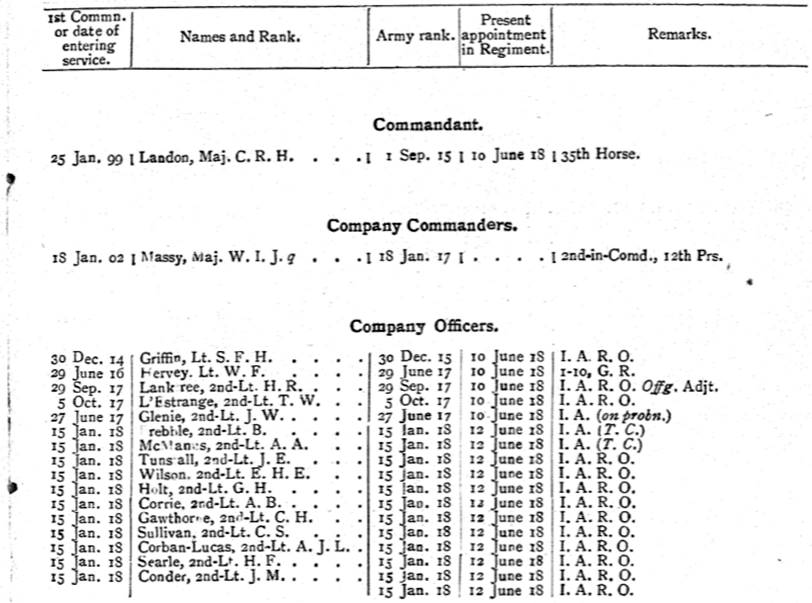This article on the 4th Battalion 70th Burma Rifles aims to help you research this war-raised Battalion and those served with it. I have written separate articles for the other three Battalions of the Regiment which can be read by clicking on the links below:
I have also written a series of guides to help you research a soldier who served in the Indian Army during the First World War. The link below will take you to the guides:
The 4th Battalion 70th Burma Rifles in the First World War
Lineage: The 4th Battalion 70th Burma Rifles was formed at Meiktila on 10 June 1918 and became the 4th Battalion 20th Burma Rifles in 1922.
Class Composition of Battalion in 1919: 2 Companies of Burmans, 1 Company of Karens and 1 Company of Shans. 1920: 2 Companies of Burmans and 2 Companies of Karens.
The 4th Battalion 70th Burma Rifles was formed at Meiktila, Central Burma, on 10 June 1918. The first commanding officer was Major Charles Richard Henry Palmer Landon who was appointed to the Battalion from the 35th Horse on 10 June 1918. The Battalion had a great difficulty in finding British officers who could speak Burmese languages and training suffered as a result. The majority of British officers who served with the Battalion were drawn from the Indian Army Reserve of Officers and had very little experience. Of the 19 British officers who were serving with the Battalion in the July 1919 Indian Army List, 11 had been commissioned in 1918 and 3 in 1917. The extract below was taken from the July 1918 Indian Army List and recorded the British officers serving with the Battalion.

Progress is being made in all respects of training. Musketry now being carried out. The chief disabilities are the lack of discipline habitual to the Burman and venereal disease. Desertion and absence without leave are slowly improving but is still prevalent. Venereal makes improvement but slowly in spite of all efforts to combat it.
In time habits of discipline and self-respect may overcome these disabilities but progress is necessarily slow amongst a race with no military traditions. On the other hand the Burman is quick to learn and has power of imparting instructions. Considering the difficulties this Battalion had in its commencement, credit is due to all for the results achieved. When there are more Regular officers available it is to be expected that a more rapid improvement will follow.
Confidential review reports on Indian Army units, depots, British officers, etc. for 1918-1919: IOR/L/MIL/7/17030
On 8 December 1919, Major Edmund Burd, 93rd Burma Infantry was appointed commanding officer and the Battalion began to improve. There is an interesting plaque to Lieutenant-Colonel Edmund Burd in the All Saints Church, Okehampton which recorded information about his career. As well as inexperienced officers, the Battalion also suffered from having to provide drafts to the other battalions of the Regiment. The Battalion remained in Burma for the duration of the war. Major-General Walter Sinclair Delamain, Commanding Burma Division reported the following in February 1920:
The excessive drain on the Battalion in the way of drafts has done much to weaken the spirit of officers and men, but morale is now improving. The other Battalions of the group are now to recruit for themselves so gradually the 4-70th should become efficient, at present its fighting value is negligible.
Confidential review reports on Indian Army units, depots, British officers, etc. for 1919-1920: IOR/L/MIL/7/17031.
The 4th Battalion, 70th Burma Rifles received another poor confidential report in February 1921:
The unit has been hampered by drafts, changes of and inexperience of officers. There has been a great deal of theft and desertions but both these are improving a great deal. Musketry much to be desired. I have every hope that under the new C.O. [Commanding Officer] Lieutenant-Colonel Wilford they will improve but I doubt their being fit to be a unit in the field for a long time.
Review reports on certain units of Indian Army 1920-1921: IOR/L/MIL/7/17032.
The Battalion was reformed in 1921 with 4 Companies of Chins and redesignated the 4th Battalion, 70th Chin Rifles. However, this title would be short-lived as following the reorganization of the Indian Army in 1922, the Battalion became the 4th Battalion, 20th Burma Rifles.
War Diaries of 4th Battalion 70th Burma Rifles
Unfortunately, there are no war diaries for the 4th Battalion 70th Burma Rifles.
Further Sources for the 4th Battalion 70th Burma Rifles
For information regarding the British and Indian (Burmese) officers who served with the 4th Battalion 70th Burma Rifles the Indian Army List should be consulted. Confidential reports for the Battalion are held at the British Library: Confidential Reports on Regiments etc. These reports also contain the annual confidential reports of the British officers who served with the Battalion.
